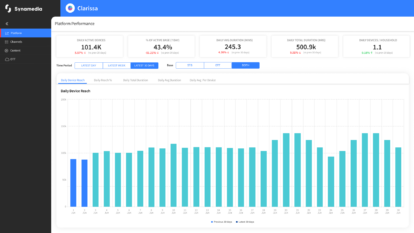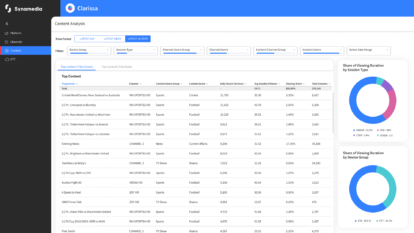In today’s video delivery landscape, whether through streaming platforms or traditional broadcast systems, ensuring consistent, high-quality content has never been more critical. As viewer expectations rise, operators face increasing pressure to monitor and optimize video quality in real time. Synamedia’s Quality-Controlled Compression, powered by the pVMAF video quality metric, provides operators with the tools to achieve this, delivering real-time insights that enhance both streaming and linear TV delivery operations.
Detailed technical insights into this groundbreaking development can be found in the following blog: Unlocking Real-Time Video Quality Measurement with x264 and pVMAF.
This innovation is driving a transformation in encoding operations, delivering three key operational advantages:
- 24/7 Real-Time Video Quality Monitoring
- Cost Optimization Through pVMAF
- Predictive Maintenance for Compression Systems
24/7 Real-Time Video Quality Monitoring
Historically, video quality assessment was limited to the testing and installation phases, relying on low-level technical monitoring such as ETR-290 alarms during ongoing operations. This approach posed challenges, including frequent alarms that were difficult to interpret in terms of their actual impact on video quality. The fundamental question—What is the actual video quality of the channel?—often remained unanswered.
Synamedia’s quality-controlled compression, powered by virtual Digital Content Manager (vDCM) technology, continuously provides reliable, standards-based video quality metrics for all channels. This allows for automated monitoring, triggering alarms when quality drops below the defined thresholds. Additionally, recordings are initiated to capture data before and during quality issues, enabling experts to conduct detailed post-event analyses.
Key Advantages:
- Eliminates the need for 24/7 manual monitoring of channel quality. Operators are alerted only when intervention is necessary.
- For Transport Stream Statmux Systems:
- Continuous monitoring resolves the challenge of assessing video quality across all channels in a statmux environment. Operators can pinpoint bandwidth constraints affecting specific channels.
- Combined with enhancements in video quality from the latest codec release and the Universal Rate Control 2.0 (URC2) algorithm, upgrading existing systems becomes a straightforward decision.
- For Streaming Solutions:
- Adaptive Bitrate (ABR) streaming typically monitors only the highest profile, leaving other profiles unchecked.
- The vDCM encoder addresses this by providing real-time quality metrics for all ABR profiles, ensuring an optimal experience across devices and network conditions.
Cost Optimization Through pVMAF
In streaming, every bit saved contributes to cost reduction. While adopting advanced codecs such as AV1 and VVC can deliver substantial savings, operators will immediately gain by transitioning to Variable Bitrate (VBR) encoding.
Unlike traditional “black box” VBR implementations, Synamedia’s vDCM provides transparency through pVMAF-based quality insights, making VBR operationally effective. Operators can specify desired pVMAF values to prioritize video quality based on channel importance.
Practical Examples:
- Assign higher pVMAF values (e.g., 95) to premium channels, moderate values (e.g., 89) to standard channels, and lower values (e.g., 80) to less critical content, optimizing overall bitrate usage.
- Dynamically adjust priorities to allocate higher quality during peak hours or high-profile events.
This granular control delivers optimal streaming cost savings while maintaining viewer satisfaction across diverse content types.
Predictive Maintenance for Compression Systems
As ABR streaming solutions mature, operational challenges emerge. Resource requirements fluctuate with content complexity, and operators must regularly update ABR ladders and bitrates. Over-provisioning CPUs to handle peak demands wastes resources while under-provisioning risks quality degradation during high-demand scenarios.
Synamedia’s elastic compression system integrates video quality data (via pVMAF) with CPU load metrics to provide actionable insights into system health. This approach enables predictive maintenance, proactively addressing potential issues before they impact video quality.
Benefits:
- Ensures consistent delivery of the highest video quality.
- Allows seamless system changes without compromising performance
Conclusion
The introduction of Synamedia’s pVMAF-based video quality metric is more than a technical advancement—it represents a paradigm shift in compression operations. By simplifying workflows, optimizing costs, and future-proofing systems for evolving market demands, this innovation sets a new standard for video encoding solutions.
About the Author
Tim has responsibility for Synamedia’s video compression and broadcast video processing with its virtual Digital Content Manager (vDCM) solution. He also leads the In-Stadium Experience product which gives fans an immersive sport experience in the stadium, on 5G and in the home.
Tim has an extensive background in engineering and product management. Prior to joining Synamedia in 2008, Tim was business development manager at IoT software company Waylay NV following 12 years at Cisco as business development manager for video solutions. He also held engineering and product management roles at Scientific Atlanta (acquired by Cisco), Barco, and Siemens, among others.












